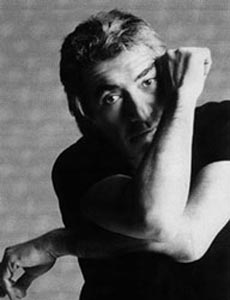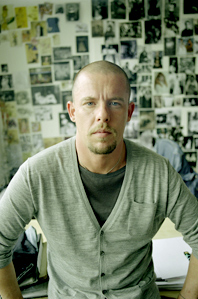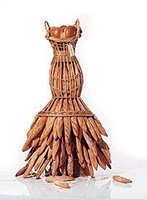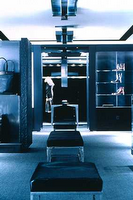Dolce & Gabbana (pronounced ['dolʧe e gab'bana]) is a high-end fashion house started by the Italian designers Domenico Dolce and Stefano Gabbana.
Dolce & Gabbana are very popular for their designs in the Hollywood industry; they have designed clothes for Madonna, Monica Bellucci, Ayumi Hamasaki, Isabella Rossellini and Kylie Minogue amongst others. The company is based in Milan. The private life of Gabbana and Dolce's affairs became public in 2005, when they officially announced their separation. The company will still stay the same, and they will continue to design together.
Dolce & Gabbana's first store in the United States opened in March 1995 in the upscale shopping mecca "the Galleria" in Houston's fashion district. Since then, a boom in interest in their clothes has called for openings of their boutiques in other major cosmopolitan cities all over the world, like London, New York, Los Angeles, Milan and Paris. Their boutiques have become a symbol of high fashion and couture.
Clothing & accessories product lines 
Male model in Dolce & Gabbana speedo-style swimsuit, 2003
Dolce & Gabbana is organized into two central lines for adults: D&G and Dolce & Gabbana. D&G generally forms the groups more casual lines with slightly cheaper prices and follows an urban inspiration. D&G follows the trends of culture of the time and is trend-setting, whereas Dolce & Gabbana centralizes on luxury materials and is slightly more expensive than the latter. The line does not change as much as D&G, and is influenced by sartorial designs, it is described as "timeless" by Dolce & Gabbana.
Both lines offer beachwear, underwear, eyewear (ophthalmic & sunglasses) and fragrances. The D&G line also carries the jewelery and timepieces.
D&G Junior is a separate line aimed at children under the age of 13. D&G Junior follows the ethos of D&G and embodies youth and fun with the styles of its clothes. Each season follows a set-named trend for a season and is named separately for boys and girls. The line contains clothes aimed at different ages of children. D&G Junior is more visibly influenced by popular culture compared to D&G, such as the Ibiza line of D&G Junior. Surprisingly, D&G Junior is distributed to more stores than the adult brands and is available outside of boutiques and department stores.
History
Domenico Dolce, was born on August 13, 1958, in Polizzi Generosa, Italy. Stefano Gabbana was born on November 14, 1962, in Venice, Italy. As students, Gabbana studied graphic design, but Dolce received a fashion education, studying in Venice and working in the small clothing factory his family owned.
In 1980, the duo met when they worked at the same atelier in Venice. They began to do freelance design in 1982, when they began doing business together. When their first collection was shown in 1986, it received acclaim from around the globe. Four years later, they revealed their premiere menswear collection and opened a women's boutique in Milan. Also in 1990, they started designing for the Complice line for the Genny Group in Milan.
Recently, the fashion house published a book chronicling ten years of Dolce & Gabbana history.
Dolce & Gabbana are on the same line of couture houses of Armani, Versace, Gucci, Prada and Moschino.
Dolce and Gabbana announced on the 20 February 2005 that they would split up after 19 years. Stefano Gabbana said that "This is a love split, not a business split,". Moreover he said "Domenico and I are still very good friends and, as for the working relationship, we are still very much together. Business, in fact, has never been better."
In 2005, in partnership with Motorola Dolce & Gabbana S.p.A. branded a gold limited edition (1000 produced) RAZR V3i, it is available exclusively through Dolce & Gabbana boutiques. It features Dolce & Gabbana logo, music and customisation, the striking gold design is its main difference to the normal RAZR. In June 2006, Dolce & Gabbana announced a second partnership with Motorola to produce another RAZR V3i in gold and silver versions. This, unlike the first mobile phone is not a limited edition and will be available from retail outlets throughout Europe. It features D&G Dolce & Gabbana branding, songs, photos and an option for a D&G branded Bluetooth headset. It is priced approximately at $550.
Generally, Dolce & Gabbana is written as previously, however it is spelled by the company when printed as Dolce&Gabbana (without the space), it is only in the logo where there is a space.
References in pop culture
Dolce & Gabbana was mentioned in the song "My Humps" by the Black Eyed Peas, Gata Sandunguera by Mey Vidal Ft. Qbanito, by LL Cool J in the song Loungin' (Who Do Ya Luv)and in the song "P.I.M.P." by 50 Cent. Kelis also mentioned the brand in the song "Daddy" on her album "Wanderland", which was not released in the United States. It was also mentioned in the song titled, "Hustler's Story" by Notorious B.I.G., on his album Duets.
Dolce & Gabbana was mentioned in the Saturday Night Live skit, "Jeffrey's".
 Roberto Cavalli (born November 15, 1940) is a well-known Italian designer of modern luxury clothing.
Roberto Cavalli (born November 15, 1940) is a well-known Italian designer of modern luxury clothing.






